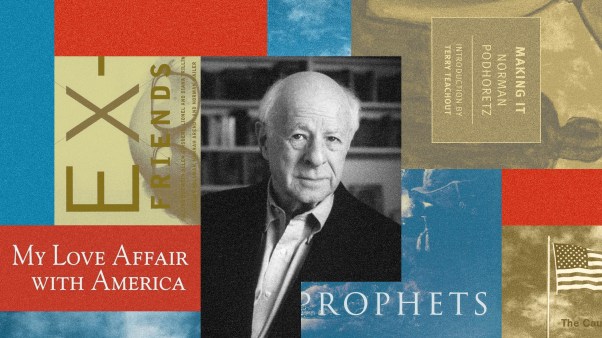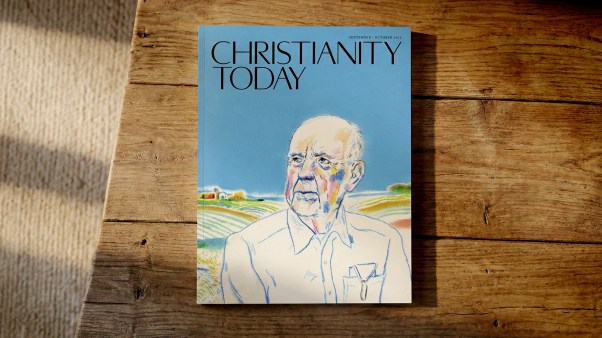Once upon a time, the Virgin Mary pervaded the life and thought of the Western world. Her presence was so expansive, in fact, that even European fairy tales acknowledged her status. Take Cinderella. An abusive stepmother was still the cause of Cinderella’s impoverished conditions, but in one of the earliest tellings of the tale, she knew the one to call upon was the Virgin Mary. In no time at all, Cinderella’s hunger was resolved, and a prince was proposing. By replacing the Virgin Mary with a Fairy Godmother, the story of Cinderella was successfully secularized for today without disenchanting it. But it’s not just fairy tales that have stripped Mary from a well-loved story. She’s missing from The Story, too.
It’s not that Protestants have entirely forgotten Mary. At this time of year, the mother of Jesus gets some attention. But Mary is not a Christmas figure to be stored away like the manger and the Star of Bethlehem until next year. She played an extraordinary role throughout the life and ministry of Jesus, from the Annunciation to the day of Pentecost. By overlooking the roles she played throughout Jesus’ ministry, we may think that we are protecting Protestantism from falling into old “Catholic” habits of elevating her beyond what Scripture declares about her. But there’s nothing “Protestant” about neglecting what Scripture does say about her—and about the other women named by the New Testament writers.
Before Easter this year, I (Jennifer) stepped out of my comfort zone and preached a sermon at a church on the women named in Luke 8, who traveled with Jesus and financially supported his ministry. In one sense, it was an obvious choice for a sermon. I wanted the congregation to know who the women of Luke 8 were before they met them again at the tomb on Easter. After all, every single Gospel account mentions that women were the first witnesses to the risen Christ. And there is no better evidence of the truth of the Christian claim that Christ truly, bodily resurrected than the fact that the Gospel writers absurdly and consistently base it on the testimony of women during a time when a woman’s testimony was legally worthless. Still, I was uncertain about how a sermon with this kind of focus would be received. Afterward, I had just a swarm of people saying to me that they had never even heard of these women before. They told me that while they had heard sermons focusing on a number of biblical characters other than Jesus, they had never heard a single Sunday morning sermon focused on a woman. And this was in a congregation that’s part of the Presbyterian Church (USA), a denomination that takes pride in its inclusion of women into all areas of ministry! As I officiated communion afterward, a line of women softly whispered to me “thank you,” some with tears in their eyes. Women have a hunger to know that women were faithful and active participants in Jesus’ ministry. They were not just recipients of his miracles. Not just people shown love and respect, but people transformed by Jesus for new life as participants and witnesses in his ministry.
Numerous women are named in Scripture as supporters and participants in Jesus’ ministry. Many more are named as co-workers with Paul. These women are not entirely forgotten by Protestant churches today, but when we tell the stories of Priscilla, Phoebe, Susanna, Chloe, Junia, or the many other women of Scripture, we almost always reserve that focus for the women’s retreat. The whole testimony of Scripture is for the whole church—both men and women. What would it mean for men in the pews to think about the examples of women not as particular “women’s stories” but as universal Christian exemplars? Women in our churches have long had to learn special listening and application skills as they considered the many examples of men following Jesus. It is the normative filter for women in the pew. What if the tables were turned to better reflect the practice of the Bible? What if the New Testament writers didn’t just name female disciples to show women that they too can participate in Jesus’ work? What if the New Testament writers also intended men to learn from women how to follow Jesus? What if Mary, the Mother of God, is for men too?
Reforming Mary
It is easy to assume that sidelining Mary has always been the case from the start of the Protestant tradition. When the Reformers turned their backs on “Papa” (or the Pope), did they not also turn their backs on “Mama”?
In truth, as the Reformers dismantled the cult of the saints, they were wary to let go of Mary. In certain regions of Germany, when nearly every feast day associated with the saints was abolished, Mary’s survived. As images and statues of the saints were destroyed due to the spread of iconoclasm, Mary’s statue was memorialized. Instead of leaving her behind, Protestants repositioned her as one of the most important examples in the Bible of justification by faith through grace alone.
Reforming the theology and practices surrounding Mary were complex, as it turned out. The first Protestant reformers, Martin Luther and Ulrich Zwingli, maintained a robust view of Mary for their generation. They did not scoff at Mary’s Immaculate Conception (the idea that Mary was born free of sin at conception) since it continued to be the best way of distancing Christ from original sin. Luther believed that by the power of the Holy Spirit, Mary continued to be sinless throughout her life, and this affirmation went hand-in-hand with the idea of her “perpetual virginity.” Zwingli and John Calvin taught this as well. For Protestants, these affirmations had less to do with Mary and everything to do with protecting Christ and the salvific nature of the Incarnation.
In this way, Mariology and Christology were significantly intertwined; untangling the two was a highly sensitive matter. By continuing to affirm Mary as the Mother of God (or theotokos), the Reformers appealed to orthodox affirmations of Christian theology rooted in the earliest ecumenical councils of the church. To Luther, the “first sermon on earth” was the proclamation that Mary was the mother of the Lord, and this was preached by no less than by a woman (Elizabeth). “No one should be afraid, if he had tough times growing up or is miserable and despised,” Luther said. “It is not a bad omen. Look at Mary’s example. And look what God made out of her! … Her renown and her honor will remain among many until the end of the world: for no one can preach Christ without speaking of his mother.”
 Giovanni B. Barchi / Semak / iStock / Getty
Giovanni B. Barchi / Semak / iStock / GettyNevertheless, there were two fundamental ways in which Protestant Reformers pushed back against the church’s teaching on Mary. Because the heart of the Protestant Reformation was determined to elevate Christ’s sacrifice on the cross as uniquely sufficient for human salvation, the reformers rejected the popular idea of Mary as a co-redeemer with Christ and her mediation of salvation within the life of the believer. Mary, who was purported to stand beside Christ on the Day of Judgment as the “Queen of Heaven” whispering words of mercy to counter his harsh judgments, was removed from the scene. The Protestant Reformers were on a mission to make Jesus more approachable, more merciful, and more gracious, which meant that Mary needed to take a motherly backseat to her son. Righting the ship meant directing the church toward grace offered through Christ on the cross alone. God did not need Mary to be merciful on his behalf.
The demotion of Mary’s role from co-mediator meant reinterpreting her significance within the salvation story. Mary shifted from medieval intercessor to a paradigmatic example of faith for Protestants. In order to do this, the Reformers had to reinterpret the medieval view of the nativity story, and the meaning of Mary as “full of grace” was the crux of the dispute. For the Roman Catholic Church this meant that Mary was deserving of God’s choosing. She was full of the virtue of humility, literally holier than thou.
In contrast, the Reformers argued that Mary was “full of grace” because God gifted her with grace. She was only worthy of God’s choosing because God’s choosing made her worthy. As Luther protested, the Magnificat (Luke 1:46–55) was not a song about how great Mary is but about how great God is. In a word, Mariology was caught in the crossfire over the true meaning of justification.
Consider the second line of the Regina Cæli, an ancient Latin Marian Hymn of the Christian Church and one of the four seasonal Marian antiphons of the Blessed Virgin Mary: “The Son you merited to bear, alleluia.” For Catholicism, Mary had merited her role as the Mother of God. For Protestantism, God chose Mary despite her lowliness and honored her beyond what she deserved. Surely there is no womb worthy of carrying the Son of God? The true message of the nativity story was that Mary heard the Good News that a child was coming and accepted God’s grace toward her with extraordinary faith. For Luther, Mary’s greatness lay in the greatness of her faith: “This virgin had a faith of which there is no equal in the entire Bible.” Mary’s example was a model of the Christian life.
Most Protestants today would not be comfortable with Medieval Luther teaching his congregants the importance of reciting the Ave Maria or his affirmation of Mary’s bodily assumption at her death (widely affirmed in Luther’s time but rendered official Roman Catholic dogma in the mid-twentieth century). But today’s Protestant church is in no danger of overemphasizing the role of Mary in the story of salvation. Rather, we underestimate her role throughout the Gospels.
More than a Mother (But Not Less)
The opening drama of the canon mentions Mary only a few times. Matthew’s genealogy leads to Joseph (Matt. 1:16), and from that point on he takes the lead. Mary is only the recipient of the action: She is betrothed (presumably by her family) to Joseph (1:18), she is discovered (presumably by Joseph) to be pregnant (1:18). He was going to put her away quietly, but instead takes her in (1:24). Matthew portrays the dramatic encounter between the angel and Joseph so that the reader can see what caused the compassionately costly change in plans. After the entry of the villain Herod, the angel comes again to Joseph and he takes his family to Egypt (2:13–14) and back again (2:21) to avoid the threat of death. Mary is carried along, not unlike her vulnerable child.
 Juan De Flandes / Met / Wikimedia Commons
Juan De Flandes / Met / Wikimedia CommonsThe text and tradition bless us with a compelling picture of a caring father in the person of Joseph, but it would be wrong to imagine that his prominence completely overshadows Mary in this account, to think that Matthew tells Joseph’s story while Luke tells Mary’s. The division is not quite so neat. Mary may remain in the background for Matthew, but this is not because her presence is unimportant. It is because she is the anchor around whom, and in whom, the action turns.
Mary is the subject of only one active verb in Matthew’s birth narrative: She bore. She bore a Son (1:21, 23). She is, Matthew says six times, his mother. Joseph exercises his faith by caring, and so too does Mary. She performs the mundane, often unnoticed but life-and-death important act of mothering. And she does so in the most dangerous of circumstances. While Joseph decides her fate, she carries this baby. While Herod schemes his death, she nurses him, changes him, feeds him, sings to him. She exercises her faith, to quote Tish Harrison Warren, in the liturgies of the ordinary, and therefore valorizes the countless women throughout time who have done the same.
Luke has much to say about her as a mother as well, but expands her active faith to include the roles of prophet and proclaimer.
Mary gets to sing the first of many solos in Luke’s Gospel. On her retreat to the house of her friend and family member, Elizabeth, when she is greeted with Elizabeth’s exuberant Holy Spirit knowledge of her pregnancy, Mary breaks forth in praise. She magnifies the Lord (1:46) who has magnified her. She praises God for being sovereign, for being holy, and most of all for being Savior. The Majestic God has paid attention to her, a slave.
She is not, however, focused on her own good fortune alone. Her story is an example—the central example since she will be the locus of the Incarnation—of the character of God. Hence when she sings God’s praise, she does so as a prophet. She speaks truth about God. She affirms who God has been in the past; she foretells who God the Son will be in the future. God has and will put down the mighty and lift up the humble. God has and will fill the hungry and send the rich away empty. Luke puts forth Mary as a prophet who knows of God’s word to Israel (her story closely mirrors the praise of Hannah in 1 Sam. 2) and knows of God’s work to come in her son.
Luke also shows Mary as a proclaimer. In the opening chapter of Acts, when the followers of Jesus are waiting in the Upper Room passionately joined together in prayer, Luke indicates that the gathering consists of both men and women, but he names only one of the latter: Mary the mother of Jesus (1:14). Luke keeps the focus on the full group at the beginning of chapter 2. All are together at the same place (2:1) when the wind and fire of the Spirit fall upon them. They all speak in different tongues, uttering just what the Spirit allowed them to utter (2:4), testifying vocally and publicly to “God’s deeds of power” (2:11) to the men gathered in Jerusalem (2:5, 14, 22, 29).
It is possible that Luke only means all of the twelve disciples (the full symbolic number just having been restored with the selection of Matthias). The twelve apostles do take a prominent place as those who stand with Peter (2:14) and receive a question from the crowd (2:37). Luke leaves several markers, however, to indicate that though the apostles are easily seen, they are not the only ones being heard. The testifying group also includes all those who gathered waiting for the coming of the Spirit. Luke leaves clues that the testifying group specifically includes Mary:
First, those who testify are called Galileans, which Luke established in his Gospel that Mary is (1:26). Second, Luke specifies that the listening crowd is made of men (he uses the more gender specific term anhr and not the more general human term anthropos). Because he uses the terms with some fluidity, this could simply be his way of referring to a mixed gender crowd with a masculine term. It is striking, however, that in the same passage where he describes the crowd as men four times, he never uses the same term for “men” to describe those who are testifying.
Most important for Mary’s inclusion in this group is Peter’s extensive citation of the prophecy of Joel. After the gospel cacophony, Peter rises to speak. What you have seen and heard, he says, is not drunkenness but a demonstration of the Spirit of God being poured upon sons and daughters. The balanced phrase is not an example of inclusive translation. “Daughters” appears in the Greek of Peter’s speech, and “daughters” appears in the Hebrew of Joel’s prophecy. His cited text from Joel also calls the anointed ones male and female slaves (doulh), a designation that Luke uses only two other times in his two-volume work, and both describe Mary, in her climactic yes to the invitation to the Incarnation (1:38) and in her Magnificat (1:48). It is little surprise that many in the Christian tradition have often believed that Mary was present at Pentecost. Mary, therefore, (along with the other women) testified vocally and publicly to the fulfillment of God’s promises in her Son Jesus. How else could Peter say that what they had seen and heard was a demonstration of this kind of work of the Spirit if Mary and the other servant daughters of the Lord had remained silent?
Hence the New Testament witness portrays Mary fulfilling a number of different callings. The Scriptural location that unites them all is the Annunciation. In this inaugural event God initiates, choosing her and sending an angel to her location to proclaim God’s favor and grace. He speaks to her first about becoming a mother: the mother of the Messiah, which will bring her great honor. But the timing is off: A pregnancy at that moment will only bring shame. With eyes wide open to the blessing and the curse, she assents. She agrees to be the site for the glory of the God who does the impossible. Her act of faith is the beginning of all of her ministry. Mary was the first to receive the Good News of Christ’s coming and to assent to it. From that point on she continued to assent, to faithfully bear and raise him to adulthood, to witness his first miracle, to demonstrate his redefinition of family through faith, to watch his death on the cross, to receive his Spirit. She was there every step along the way as faithful witness, supporter, and proclaimer of Christ.
Blessed Is She Who Has Believed
In this day and age, it is easy to overlook the fact that the Bible names ordinary people on its pages alongside the names of emperors. When compared with the literature of its time, this is truly audacious. The fact that the Bible records the names of women at all was an extraordinary, unheard of practice. That means that when the Bible names women, it is doing something special that requires our notice. When we see a woman’s name in Scripture, whether once or many times, something extraordinary is happening that requires our attention.
So when the Gospel writers keep naming Mary’s involvement with Jesus’ ministry, it’s a big deal—it’s not a simple roll call with Mary thrown in with Thaddeus and Andrew. The Gospel writers want us to understand how important Mary was, serving from the Annunciation to Pentecost as both God-bearer in her physical body and as gospel-bearer, a faithful witness and proclaimer to the work that God was accomplishing in our Lord Jesus Christ. Both her identities matter, and they were never at odds. In everything she did, she was a faithful follower of Christ, first and foremost. She never deserted him. She listened to him teach, she watched him heal, and she never doubted that he could do the miraculous, according to the stories that Scripture has revealed. She knew who Christ was before anyone did because she was the very first person to whom God chose to reveal Christ’s identity. The pattern of Christ’s resurrection-reveal to women has a precursor.
The entire Christian life is, in a way, mirrored by the experience of Mary. Each one of us—both male and female—are called to live in Christ and he in us. We are all expected to carry Christ at the core of our being—like Mary carried Christ in her womb—and to labor with him and for him. But unlike a human mother giving life to a human child, Christ gives us new life by his indwelling. Who better to reflect that truth of the Christian life than the one who literally bore Jesus on our behalf through the power of the Holy Spirit? Mary is for both men and women. All of us are invited to follow this first follower as she followed Christ.
Jennifer Powell McNutt is the Franklin S. Dyrness Chair in Biblical and Theological Studies at Wheaton College, parish associate at First Presbyterian Church of Glen Ellyn, Illinois, and co-founder of McNuttshell Ministries, Inc. Amy Beverage Peeler is associate professor of New Testament at Wheaton and associate rector of St. Mark’s Church in Geneva, Illinois.












